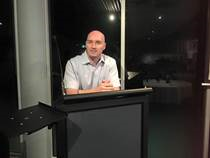Question & Answer - Oral Sensory-Motor, Myofunctional, Vocal Tract, & Airway Information
What are some important thoughts to consider relative to sleep disordered breathing?By David McIntosh; MBBS, FRACS, PhD; Paediatric ENT Specialist; Associate Professor, James Cook University in AustraliaDecember 2019 |
|||
|
I posted the following 10 ideas in a few forums, and they have had mixed reactions. I provide one paper per point. I encourage people to read more about each point to attain a broad appreciation of the topic as the following 10 concepts are inevitably simplifications of complicated topics.
I’ve been managing sleep disordered breathing (SDB) for over 17 years. I like challenging paradigms to help people think about them. I’m going to give you a list of 10 items the literature says you may be surprised to learn. Thoughts to Consider Number 1: Pediatric sleep studies do not diagnose sleep disordered breathing (Smith, Gozal, Hunter, & Kheirandish-Gozal, 2017) Number 2: Pediatric sleep studies do not tell you which kids need surgery (Smith, Gozal, Hunter, & Kheirandish-Gozal, 2017) Number 3: Adeno-tonsillectomy for SDB in children works 80% of the time in the short term and 65% for the long term (Chang, & Chiang, 2017) Number 4: If a child has SDB and an orthodontic problem, the orthodontic outcomes seem to be better if the kids get their breathing sorted first (Pereira, Bakor, & Weckx, 2011) Number 5: Mouth breathing does not cause big tonsils (Proenca-Modena, Valera, Jacob, Buzatto, Saturno, Lopes, ... & Tamashiro, 2012) Number 6: Oral sleep appliances do not work by pulling the tongue forward away from the posterior pharyngeal wall (Bamagoos, Cistulli, Sutherland, Ngiam, Burke, Bilston, ... & Eckert, 2019) Number 7: Bruxism is triggered by hypoxia (Schames, Schames, Schames, & Chagall-Gungur, 2012) Number 8: You need 4 nights in a row of measuring with a sleep study in adults to get reliable data (Alshaer, Ryan, Fernie, & Bradley, 2018) Number 9: Snoring in adults is enough to increase the risk of carotid artery atherosclerosis (Deeb, Smeds, Peterson, Roberts, Beckman, ... & Yaremchuk, 2019) Number 10: The argument over an oral appliance versus CPAP (continuous positive airway pressure) is the wrong argument (El-Solh, Moitheennazima, Akinnusi, Churder, & Lafornara, 2011) Now I know, from experience, when people read or hear these sorts of things, they say or think: “But, I thought...” All I ask is prior to taking comeuppance to the above ideas, pause and reflect. I wouldn’t be saying these things if I could not back them up. So, if anyone is curious and wants to discuss these concepts, I am happy to do so. However, I encourage the self-directed exploration of the topics to immerse yourselves in the science to attain a broad understanding of the actual complexity of these issues. References Alshaer, H., Ryan, C., Fernie, G. R., & Bradley, T. D. (2018). Reproducibility and predictors of the apnea hypopnea index across multiple nights. Sleep Science, 11(1), 28. Bamagoos, A. A., Cistulli, P. A., Sutherland, K., Ngiam, J., Burke, P. G., Bilston, L. E., ... & Eckert, D. J. (2019). Dose-dependent effects of mandibular advancement on upper airway collapsibility and muscle function in obstructive sleep apnea. Sleep, 42(6), zsz049. Chang, T. S., & Chiang, R. P. Y. (2017). Total analysis of clinical factors for surgical success of adenotonsillectomy in pediatric OSAS. European Archives of Oto-Rhino-Laryngology, 274(1), 561-566. Deeb, R., Smeds, M. R., Bath, J., Peterson, E., Roberts, M., Beckman, N., ... & Yaremchuk, K. (2019). Snoring and carotid artery disease: A new risk factor emerges. The Laryngoscope, 129(1), 265-268. El-Solh, A. A., Moitheennazima, B., Akinnusi, M. E., Churder, P. M., & Lafornara, A. M. (2011). Combined oral appliance and positive airway pressure therapy for obstructive sleep apnea: a pilot study. Sleep and Breathing, 15(2), 203-208. Pereira, S. R. A., Bakor, S. F., & Weckx, L. L. M. (2011). Adenotonsillectomy in facial growing patients: spontaneous dental effects. Brazilian journal of otorhinolaryngology, 77(5), 600-604. Proenca-Modena, J. L., Valera, F. C. P., Jacob, M. G., Buzatto, G. P., Saturno, T. H., Lopes, L., ... & Tamashiro, E. (2012). High rates of detection of respiratory viruses in tonsillar tissues from children with chronic adenotonsillar disease. PLoS One, 7(8), e42136. Schames, S. E., Schames, J., Schames, M., & Chagall-Gungur, S. S. (2012). Sleep bruxism, an autonomic self-regulating response by triggering the trigeminal cardiac reflex. Journal of the California Dental Association, 40(8), 670-1. Smith, D. L., Gozal, D., Hunter, S. J., & Kheirandish-Gozal, L. (2017). Frequency of snoring, rather than apnea–hypopnea index, predicts both cognitive and behavioral problems in young children. Sleep medicine, 34, 170-178. About the Author Associate Professor Dr. David McIntosh of ENT Specialists Australia was kind enough to write this month’s Q & A. David also contributes to Facebook groups collaborating with other specialists who manage breathing problems in kids. They talk about mouth breathing, and David contributes amazing knowledge about how mouth breathing can lead to serious heart problems. David has kindly contributed this Q & A in the hope that parents will take a more proactive role in finding breathing problems in their own children and insist doctors take their concerns seriously. David is a Paediatric ENT Specialist with a particular interest in airway obstruction, facial and dental development and its relationship to ENT airway problems, and middle ear disease. He also specialises in sinus disease and provides opinions on the benefit of revision of previous sinus operations. He is passionate about Indigenous Health. And, he has undertaken advanced surgical training in ENT and Head and Neck Surgery and Paediatric training at Starship Children’s Hospital in Auckland, New Zealand. He is the author of Snored to Death: Are you dying in your sleep? Contact Information: |
|||
|
|
